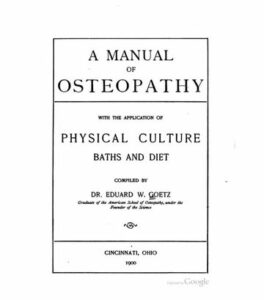A Manual of Osteopathy – with the Application of Physical Culture, Baths and Diet by Eduard W Goetz
Very schematic volume, with the aim of spreading the osteopathic application techniques to everybody, even to those lacking any sort of health training.

Publisher: Sconosciuto, Cincinnati, Ohio
Year of publication: 1900
Number of pages: 185
In the preface to the volume Goets affirms to have intentionally avoided any scientific vocabulary to make the reading of the book accessible to everyone. He declares that osteopathy as founded by Dr Still is just at the beginning, it is not a secret or a supernatural technique and it is applicable by anyone.
After a brief explanation in which the author enunciates the fundamental principles of osteopathy, the book continues with the listing of a golden rule (do not take drugs during this treatment) and 15 other rules to observe when treating the patients (eg, do not use the tip of the fingers, do not cause pain to the patient, do not treat the spine below the twelfth vertebra in pregnant women or during their menstrual cycle, do not prolong the treatment for more than 20 minutes).
Less than 20 pages describe anatomy, physiology, afferent and efferent nerves.
A series of tables and photographs (pages 30-75) with short explanatory captions briefly describe the maneuvers applicable by the osteopath.
The pathologies are grouped into categories (pathologies of the head, throat, heart, lungs, abdomen, skin and women’s conditions). For each disorder a brief description is given, followed by its causes, symptoms, and advice on the suggested treatment, diet and exercises.
The book closes with a few chapters on diet, hot and cold baths and physical activity. The last two pages contain a list of the nervous centers to focus on based on the pathology to be treated.
There is news of a second edition with copyright of 1905, published in 1908 by Nature’s Cure, Cincinnati (Ohio), and of a third and fourth edition, written together with Charles Feckel Conrad, published in 1919 in New York by University Book Co.
Strengths: the volume contains an initial index and an analytical index for easy reference. The schematic exposition is very clear.
Weaknesses: this volume is amongst those condemned by the AOA for undermining the science of osteopathy.

Are you an osteopath?
Register and enjoy the membership benefits. Create your public profile and publish your studies. It's free!
Register now
School or training institution?
Register and enjoy the membership benefits. Create your public profile and publish your studies. It's free!
Register now
Do you want to become an osteopath? Are you a student?
Register and enjoy the membership benefits. Create your public profile and publish your studies. It's free!
Register nowHistorical osteopathy books
Osteopathy Research and Practice by Andrew Taylor Still
The fourth book of A.T. Still, written at the age of 82 years, enunciates the principles and the practical maneuvers of osteopathy in reference to the single pathologies, classified by body regions.
ReadHistory of Osteopathy and Twentieth-Century Medical Practice by Emmons Rutledge Booth
A milestone in the history of osteopathy. Emmons Rutledge Booth, who enrolled at the ASO in Kirksville in 1898 and graduated in 1900, met A.T. Still personally.
ReadPhilosophy of Osteopathy by Andrew Taylor Still
The second book published by A.T. Still, it collects the basic principles of osteopathy, written over several years and then gathered in one volume. Despite the insistence of his friends, Still was not sure that the time was ripe to divulge his early science.
ReadAutobiography of Andrew Taylor Still with a History of the Discovery and Development of the Science of Osteopathy by A. T. Still
A fundamental text to begin to know the founder of osteopathy and to understand the cultural context and the historical events during which his life unfolded.
ReadPrimitive Physick: or, an Easy and Natural Method of Curing most Diseases by John Wesley
A fundamental text for the Methodists, which Still’s father surely knew and probably owned - in addition to remedies, the book contains a preface that dispenses advice for a healthy life.
ReadThe Old Doctor by Leon Elwin Page
A small volume dedicated to the story of Andrew Taylor Still, and to the birth and development of the idea of osteopathy.
ReadThe Cure of Disease by Osteopathy, Hydropathy and Hygiene A Book for the People by Ferdinand L. Matthay
A small volume addressed to the general public, dispensing health advice and illustrating some osteopathic techniques.
ReadOsteopathy; the New Science by William Livingston Harlan
The volume collects and comments a series of relevant articles on the new science of osteopathy, highlighting legal, historical and theoretical aspects.
ReadOsteopathy Illustrated: a Drugless System of Healing by Andrew Paxton Davis
A substantial and in-depth volume, written by a physician who participated in the first course of the ASO and then tried to integrate osteopathy into other care systems like chiropractic and neuropathy.
Read







